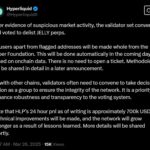In a noteworthy event in Washington, D.C., World Liberty Financial (WLFI), a new financial protocol backed by former President Donald Trump and his family, showcased its ambition to enter the cryptocurrency market by pitching its own stablecoin. The event, attended by prominent lawmakers, highlighted ongoing discussions about U.S. policy on digital assets and the regulation of stablecoins.
During the gathering, Donald Trump Jr. addressed attendees via video, expressing his enthusiasm for the future of banking through innovative technologies like blockchain. He hinted at his faith in a modernized financial system, suggesting that the existing methods may not be the most effective. WLFI has confirmed the launch of its USD1 stablecoin, with plans to initially operate on the Ethereum blockchain, as well as the Binance-linked BNB Chain.
“I’m just super excited about what this can mean for the future of banking,” Trump Jr. remarked, signaling the growing interest in digital financial solutions.
Zach Witkoff, one of the co-founders of WLFI, shared a positive outlook on the stablecoin, anticipating strong adoption from both retail customers and institutions. The event served as a platform for the firm, followed by discussions involving key legislators like Senator Tim Scott and Representative French Hill, who are instrumental in shaping potential stablecoin legislation. Their efforts aim to position the U.S. as a leading hub for dollar-backed stablecoins, paving the way for regulatory clarity in this dynamic sector.
“You don’t make permanent change in policy though executive action,” noted Rep. Hill, emphasizing the importance of legislative leadership in establishing a stablecoin regime.
As discussions about cryptocurrency regulation intensify, the House is gearing up to reintroduce a market structure bill that previously gained traction with bipartisan support. Trump Jr. described stablecoin usage as comparably safe to traditional bank accounts, while criticizing the inefficiencies of the legacy banking system. He declared, “The sky is the limit for this,” reflecting a sound confidence in the transformative potential of stablecoins.
WLFI’s vision extends beyond just cryptocurrency transactions; they aim to create an environment where everyday purchases can be made using stablecoins, as exemplified by their ambition for customers to buy products at local stores. This ambitious outlook aims to bring cryptocurrency into the daily lives of consumers, suggesting a future where digital assets seamlessly integrate with conventional commerce.

Key Points on World Liberty Financial’s Stablecoin Launch
The recent announcement by World Liberty Financial (WLFI) regarding its stablecoin has significant implications for the future of finance and everyday transactions. Here are the key points to consider:
- World Liberty Financial Connection to Donald Trump
- Financial protocol backed by President Donald Trump and his family.
- Donald Trump Jr. actively promotes the potential of digital assets.
- Launch of USD1 Stablecoin
- Stablecoin will first be available on Ethereum and BNB Chain.
- Aims to provide a stable and efficient alternative to traditional banking.
- Legislative Support for Stablecoins
- Congress is advancing legislation to regulate stablecoins.
- Key lawmakers are supportive of creating a stablecoin regime to foster growth.
- Consumer Impact and Adoption
- Potential for retail and institutions to utilize the USD1 stablecoin.
- Proposal for everyday transactions using stablecoins (e.g., buying groceries).
- Future of Banking and Financial Systems
- Trump Jr. suggests that stablecoin can streamline banking, reducing waste in the system.
- The concept of stablecoins being “as safe as a bank account” could attract skepticism and trust from users.
“Stablecoin use is ‘just as safe as a bank account, but without all that extra nonsense.’ – Donald Trump Jr.”
World Liberty Financial’s Stablecoin: A New Player in the Crypto Landscape
The emergence of World Liberty Financial (WLFI) and its recently announced USD1 stablecoin is stirring the pot in the already competitive world of digital currencies. Backed by prominent figures, including Donald Trump Jr., WLFI is stepping into a market that has seen various players, each providing their own spin on stablecoins. For example, Tether and USDC have established their dominance by offering a strong sense of trust and regulatory compliance. WLFI aims to differentiate itself through the connection with Trump and a focus on mainstream adoption, including everyday transactions like buying a sandwich.
Competitive Advantages: WLFI enters a market ripe for innovation, particularly with the close ties to political figures who are driving stablecoin legislation in Congress. This political backing could grant WLFI a considerable edge in terms of regulatory acceptance, potentially allowing them to become a go-to option as the U.S. stabilizes its policies around digital assets. Furthermore, WLFI’s ambition to make stablecoins as practical as cash in daily life puts it in alignment with broader financial inclusion efforts, appealing to both retail users and larger institutions seeking innovative financial solutions.
Competitive Disadvantages: However, WLFI’s strong association with the Trump brand could deter some potential users who may view the connection with skepticism, especially given recent political controversies. Additionally, as the regulatory environment evolves, there is a risk that new legislation could impose restrictions that may hinder WLFI’s operational flexibility compared to more established stablecoins. Users may prefer the reliability and familiar reputation that existing stablecoins offer, making customer trust an uphill battle for WLFI.
This new contender could particularly benefit tech-savvy individuals and retailers open to adopting blockchain technologies, who are looking for simple payment solutions. Conversely, more traditional banking institutions and mainstream consumers accustomed to existing financial systems might face confusion or ambiguity regarding this new offering, which could complicate its acceptance in the larger financial ecosystem.

















